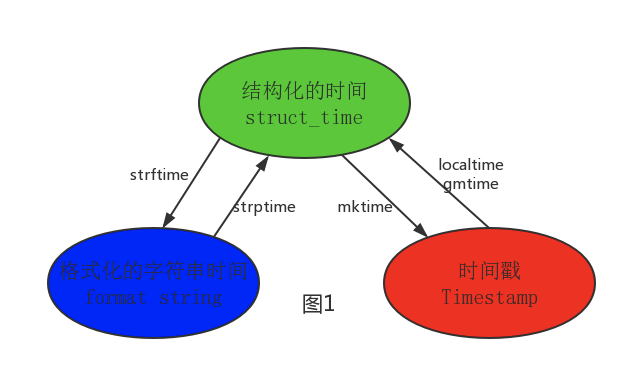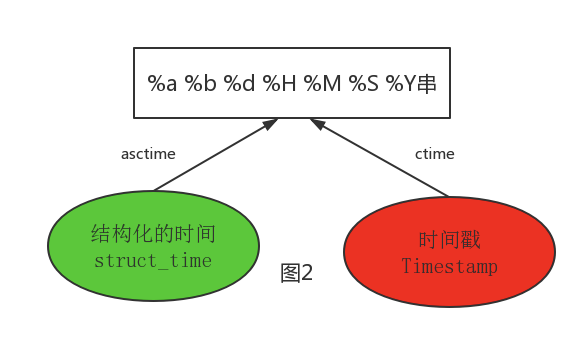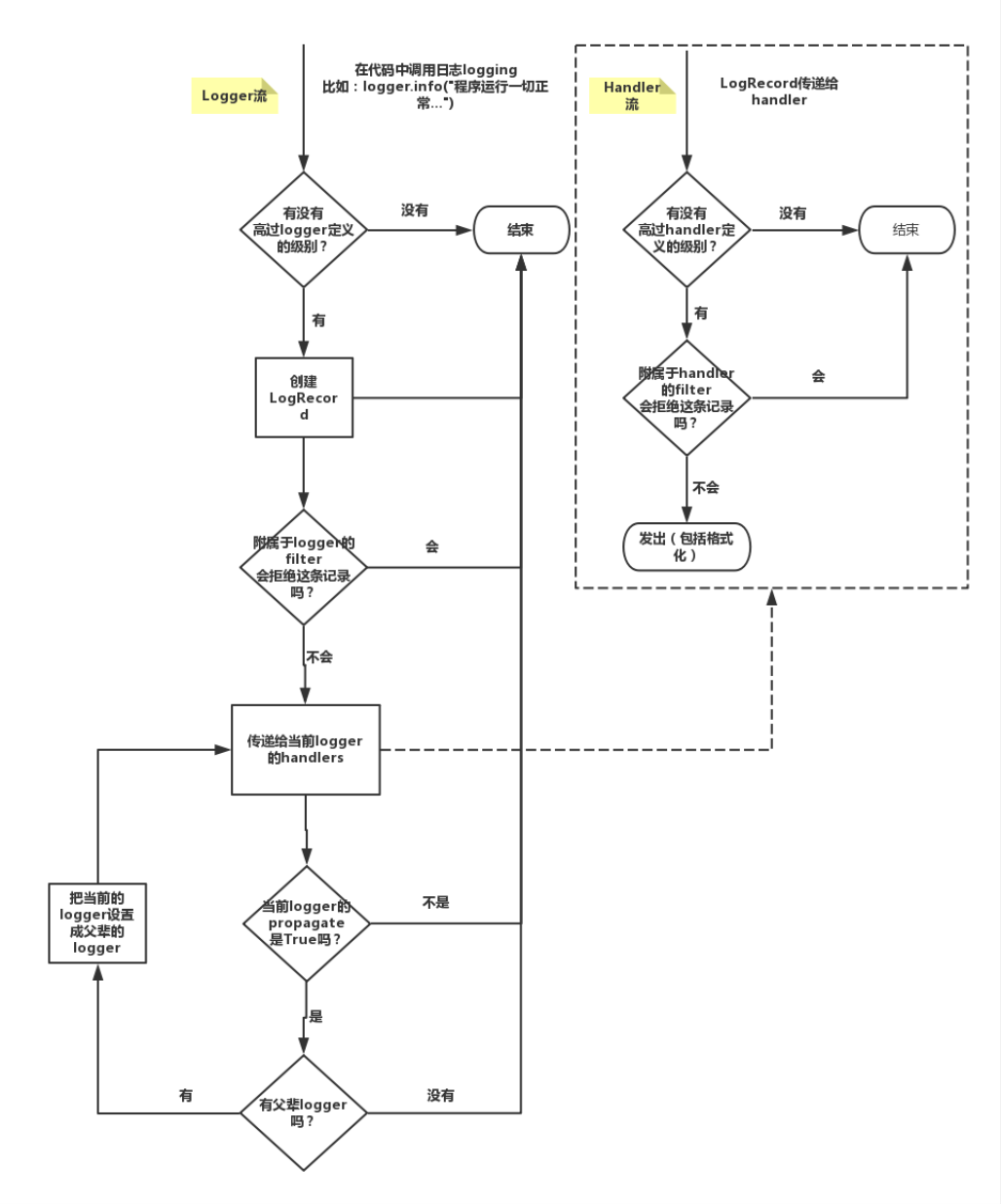python3常用模块--熟练使用
一、time与datetime模块
在Python中,通常有这几种方式来表示时间:
- 时间戳(timestamp):通常来说,时间戳表示的是从1970年1月1日00:00:00开始按秒计算的偏移量。我们运行“type(time.time())”,返回的是float类型。
- 格式化的时间字符串(Format String)
- 结构化的时间(struct_time):struct_time元组共有9个元素共九个元素:(年,月,日,时,分,秒,一年中第几周,一年中第几天,夏令时)
1 import time
2 #--------------------------我们先以当前时间为准,让大家快速认识三种形式的时间
3 print(time.time()) # 时间戳:1487130156.419527
4 print(time.strftime("%Y-%m-%d %X")) #格式化的时间字符串:'2017-02-15 11:40:53'
5
6 print(time.localtime()) #本地时区的struct_time
7 print(time.gmtime()) #UTC时区的struct_time

%a Locale’s abbreviated weekday name. %A Locale’s full weekday name. %b Locale’s abbreviated month name. %B Locale’s full month name. %c Locale’s appropriate date and time representation. %d Day of the month as a decimal number [01,31]. %H Hour (24-hour clock) as a decimal number [00,23]. %I Hour (12-hour clock) as a decimal number [01,12]. %j Day of the year as a decimal number [001,366]. %m Month as a decimal number [01,12]. %M Minute as a decimal number [00,59]. %p Locale’s equivalent of either AM or PM. (1) %S Second as a decimal number [00,61]. (2) %U Week number of the year (Sunday as the first day of the week) as a decimal number [00,53]. All days in a new year preceding the first Sunday are considered to be in week 0. (3) %w Weekday as a decimal number [0(Sunday),6]. %W Week number of the year (Monday as the first day of the week) as a decimal number [00,53]. All days in a new year preceding the first Monday are considered to be in week 0. (3) %x Locale’s appropriate date representation. %X Locale’s appropriate time representation. %y Year without century as a decimal number [00,99]. %Y Year with century as a decimal number. %z Time zone offset indicating a positive or negative time difference from UTC/GMT of the form +HHMM or -HHMM, where H represents decimal hour digits and M represents decimal minute digits [-23:59, +23:59]. %Z Time zone name (no characters if no time zone exists). %% A literal '%' character.
其中计算机认识的时间只能是'时间戳'格式,而程序员可处理的或者说人类能看懂的时间有: '格式化的时间字符串','结构化的时间' ,于是有了下图的转换关系

#--------------------------按图1转换时间
# localtime([secs])
# 将一个时间戳转换为当前时区的struct_time。secs参数未提供,则以当前时间为准。
time.localtime()
time.localtime(1473525444.037215)
# gmtime([secs]) 和localtime()方法类似,gmtime()方法是将一个时间戳转换为UTC时区(0时区)的struct_time。
# mktime(t) : 将一个struct_time转化为时间戳。
print(time.mktime(time.localtime()))#1473525749.0
# strftime(format[, t]) : 把一个代表时间的元组或者struct_time(如由time.localtime()和
# time.gmtime()返回)转化为格式化的时间字符串。如果t未指定,将传入time.localtime()。如果元组中任何一个
# 元素越界,ValueError的错误将会被抛出。
print(time.strftime("%Y-%m-%d %X", time.localtime()))#2016-09-11 00:49:56
# time.strptime(string[, format])
# 把一个格式化时间字符串转化为struct_time。实际上它和strftime()是逆操作。
print(time.strptime('2011-05-05 16:37:06', '%Y-%m-%d %X'))
#time.struct_time(tm_year=2011, tm_mon=5, tm_mday=5, tm_hour=16, tm_min=37, tm_sec=6,
# tm_wday=3, tm_yday=125, tm_isdst=-1)
#在这个函数中,format默认为:"%a %b %d %H:%M:%S %Y"。

1 #--------------------------按图2转换时间 2 # asctime([t]) : 把一个表示时间的元组或者struct_time表示为这种形式:'Sun Jun 20 23:21:05 1993'。 3 # 如果没有参数,将会将time.localtime()作为参数传入。 4 print(time.asctime())#Sun Sep 11 00:43:43 2016 5 6 # ctime([secs]) : 把一个时间戳(按秒计算的浮点数)转化为time.asctime()的形式。如果参数未给或者为 7 # None的时候,将会默认time.time()为参数。它的作用相当于time.asctime(time.localtime(secs))。 8 print(time.ctime()) # Sun Sep 11 00:46:38 2016 9 print(time.ctime(time.time())) # Sun Sep 11 00:46:38 2016
1 #--------------------------其他用法 2 # sleep(secs) 3 # 线程推迟指定的时间运行,单位为秒。
-
datetime模块
#时间加减 import datetime # print(datetime.datetime.now()) #返回 2016-08-19 12:47:03.941925 #print(datetime.date.fromtimestamp(time.time()) ) # 时间戳直接转成日期格式 2016-08-19 # print(datetime.datetime.now() ) # print(datetime.datetime.now() + datetime.timedelta(3)) #当前时间+3天 # print(datetime.datetime.now() + datetime.timedelta(-3)) #当前时间-3天 # print(datetime.datetime.now() + datetime.timedelta(hours=3)) #当前时间+3小时 # print(datetime.datetime.now() + datetime.timedelta(minutes=30)) #当前时间+30分 # # c_time = datetime.datetime.now() # print(c_time.replace(minute=3,hour=2)) #时间替换
二、random模块
import random print(random.random())#(0,1)----float 大于0且小于1之间的小数 print(random.randint(1,3)) #[1,3] 大于等于1且小于等于3之间的整数 print(random.randrange(1,3)) #[1,3) 大于等于1且小于3之间的整数 print(random.choice([1,'23',[4,5]]))#1或者23或者[4,5] print(random.sample([1,'23',[4,5]],2))#列表元素任意2个组合 print(random.uniform(1,3))#大于1小于3的小数,如1.927109612082716 item=[1,3,5,7,9] random.shuffle(item) #打乱item的顺序,相当于"洗牌" print(item)

import random
def make_code(n):
res=''
for i in range(n):
s1=chr(random.randint(65,90))
s2=str(random.randint(0,9))
res+=random.choice([s1,s2])
return res
print(make_code(9))
三、os模块
os模块是与操作系统交互的一个接口
os.getcwd() 获取当前工作目录,即当前python脚本工作的目录路径
os.chdir("dirname") 改变当前脚本工作目录;相当于shell下cd
os.curdir 返回当前目录: ('.')
os.pardir 获取当前目录的父目录字符串名:('..')
os.makedirs('dirname1/dirname2') 可生成多层递归目录
os.removedirs('dirname1') 若目录为空,则删除,并递归到上一级目录,如若也为空,则删除,依此类推
os.mkdir('dirname') 生成单级目录;相当于shell中mkdir dirname
os.rmdir('dirname') 删除单级空目录,若目录不为空则无法删除,报错;相当于shell中rmdir dirname
os.listdir('dirname') 列出指定目录下的所有文件和子目录,包括隐藏文件,并以列表方式打印
os.remove() 删除一个文件
os.rename("oldname","newname") 重命名文件/目录
os.stat('path/filename') 获取文件/目录信息
os.sep 输出操作系统特定的路径分隔符,win下为"\\",Linux下为"/"
os.linesep 输出当前平台使用的行终止符,win下为"\t\n",Linux下为"\n"
os.pathsep 输出用于分割文件路径的字符串 win下为;,Linux下为:
os.name 输出字符串指示当前使用平台。win->'nt'; Linux->'posix'
os.system("bash command") 运行shell命令,直接显示
os.environ 获取系统环境变量
os.path.abspath(path) 返回path规范化的绝对路径
os.path.split(path) 将path分割成目录和文件名二元组返回
os.path.dirname(path) 返回path的目录。其实就是os.path.split(path)的第一个元素
os.path.basename(path) 返回path最后的文件名。如何path以/或\结尾,那么就会返回空值。即os.path.split(path)的第二个元素
os.path.exists(path) 如果path存在,返回True;如果path不存在,返回False
os.path.isabs(path) 如果path是绝对路径,返回True
os.path.isfile(path) 如果path是一个存在的文件,返回True。否则返回False
os.path.isdir(path) 如果path是一个存在的目录,则返回True。否则返回False
os.path.join(path1[, path2[, ...]]) 将多个路径组合后返回,第一个绝对路径之前的参数将被忽略
os.path.getatime(path) 返回path所指向的文件或者目录的最后存取时间
os.path.getmtime(path) 返回path所指向的文件或者目录的最后修改时间
os.path.getsize(path) 返回path的大小
在Linux和Mac平台上,该函数会原样返回path,在windows平台上会将路径中所有字符转换为小写,并将所有斜杠转换为饭斜杠。
>>> os.path.normcase('c:/windows\\system32\\')
'c:\\windows\\system32\\'
规范化路径,如..和/
>>> os.path.normpath('c://windows\\System32\\../Temp/')
'c:\\windows\\Temp'
>>> a='/Users/jieli/test1/\\\a1/\\\\aa.py/../..'
>>> print(os.path.normpath(a))
/Users/jieli/test1
os路径处理
#方式一:推荐使用
import os
#具体应用
import os,sys
possible_topdir = os.path.normpath(os.path.join(
os.path.abspath(__file__),
os.pardir, #上一级
os.pardir,
os.pardir
))
sys.path.insert(0,possible_topdir)
#方式二:不推荐使用
os.path.dirname(os.path.dirname(os.path.dirname(os.path.abspath(__file__))))
四、sys模块
sys.argv 命令行参数List,第一个元素是程序本身路径 sys.exit(n) 退出程序,正常退出时exit(0) sys.version 获取Python解释程序的版本信息 sys.maxint 最大的Int值 sys.path 返回模块的搜索路径,初始化时使用PYTHONPATH环境变量的值 sys.platform 返回操作系统平台名称
打印进度条
#=========知识储备==========
#进度条的效果
[# ]
[## ]
[### ]
[#### ]
#指定宽度
print('[%-15s]' %'#')
print('[%-15s]' %'##')
print('[%-15s]' %'###')
print('[%-15s]' %'####')
#打印%
print('%s%%' %(100)) #第二个%号代表取消第一个%的特殊意义
#可传参来控制宽度
print('[%%-%ds]' %50) #[%-50s]
print(('[%%-%ds]' %50) %'#')
print(('[%%-%ds]' %50) %'##')
print(('[%%-%ds]' %50) %'###')
#=========实现打印进度条函数==========
import sys
import time
def progress(percent,width=50):
if percent >= 1:
percent=1
show_str=('[%%-%ds]' %width) %(int(width*percent)*'#')
print('\r%s %d%%' %(show_str,int(100*percent)),file=sys.stdout,flush=True,end='')
#=========应用==========
data_size=1025
recv_size=0
while recv_size < data_size:
time.sleep(0.1) #模拟数据的传输延迟
recv_size+=1024 #每次收1024
percent=recv_size/data_size #接收的比例
progress(percent,width=70) #进度条的宽度70
优化版本:
def progress(percent,width=50):
if percent > 1:
percent=1
show_str=('[%%-%ds]' %width) %(int(width*percent) * '#')
print('\r%s %d%%' %(show_str,int(100*percent)),end='')
import time
recv_size=0
total_size=100
while recv_size < total_size:
time.sleep(0.1)
recv_size+=1
percent=recv_size / total_size
progress(percent)
五、shutil模块
高级的 文件、文件夹、压缩包 处理模块
shutil.copyfileobj(fsrc, fdst[, length])
将文件内容拷贝到另一个文件中
import shutil
shutil.copyfileobj(open('old.xml','r'), open('new.xml', 'w'))
shutil.copyfile(src, dst)
拷贝文件
shutil.copyfile('f1.log', 'f2.log') #目标文件无需存在
shutil.copymode(src, dst)
仅拷贝权限。内容、组、用户均不变
shutil.copymode('f1.log', 'f2.log') #目标文件必须存在
shutil.copystat(src, dst)
仅拷贝状态的信息,包括:mode bits, atime, mtime, flags
shutil.copystat('f1.log', 'f2.log') #目标文件必须存在
shutil.copy(src, dst)
拷贝文件和权限
import shutil
shutil.copy('f1.log', 'f2.log')
shutil.copy2(src, dst)
拷贝文件和状态信息
import shutil
shutil.copy2('f1.log', 'f2.log')
shutil.ignore_patterns(*patterns)
shutil.copytree(src, dst, symlinks=False, ignore=None)
递归的去拷贝文件夹
import shutil
shutil.copytree('folder1', 'folder2', ignore=shutil.ignore_patterns('*.pyc', 'tmp*')) #目标目录不能存在,注意对folder2目录父级目录要有可写权限,ignore的意思是排除

import shutil
shutil.copytree('f1', 'f2', symlinks=True, ignore=shutil.ignore_patterns('*.pyc', 'tmp*'))
'''
通常的拷贝都把软连接拷贝成硬链接,即对待软连接来说,创建新的文件
'''
shutil.rmtree(path[, ignore_errors[, onerror]])
递归的去删除文件
import shutil
shutil.rmtree('folder1')
shutil.move(src, dst)
递归的去移动文件,它类似mv命令,其实就是重命名。
import shutil
shutil.move('folder1', 'folder3')
shutil.make_archive(base_name, format,...)
创建压缩包并返回文件路径,例如:zip、tar
创建压缩包并返回文件路径,例如:zip、tar
- base_name: 压缩包的文件名,也可以是压缩包的路径。只是文件名时,则保存至当前目录,否则保存至指定路径,
如 data_bak =>保存至当前路径
如:/tmp/data_bak =>保存至/tmp/ - format: 压缩包种类,“zip”, “tar”, “bztar”,“gztar”
- root_dir: 要压缩的文件夹路径(默认当前目录)
- owner: 用户,默认当前用户
- group: 组,默认当前组
- logger: 用于记录日志,通常是logging.Logger对象
#将 /data 下的文件打包放置当前程序目录
import shutil
ret = shutil.make_archive("data_bak", 'gztar', root_dir='/data')
#将 /data下的文件打包放置 /tmp/目录
import shutil
ret = shutil.make_archive("/tmp/data_bak", 'gztar', root_dir='/data')
shutil 对压缩包的处理是调用 ZipFile 和 TarFile 两个模块来进行的,详细:

import zipfile
# 压缩
z = zipfile.ZipFile('laxi.zip', 'w')
z.write('a.log')
z.write('data.data')
z.close()
# 解压
z = zipfile.ZipFile('laxi.zip', 'r')
z.extractall(path='.')
z.close()

import tarfile
# 压缩
>>> t=tarfile.open('/tmp/egon.tar','w')
>>> t.add('/test1/a.py',arcname='a.bak')
>>> t.add('/test1/b.py',arcname='b.bak')
>>> t.close()
# 解压
>>> t=tarfile.open('/tmp/egon.tar','r')
>>> t.extractall('/egon')
>>> t.close()
六、json&pickle模块
之前我们学习过用eval内置方法可以将一个字符串转成python对象,不过,eval方法是有局限性的,对于普通的数据类型,json.loads和eval都能用,但遇到特殊类型的时候,eval就不管用了,所以eval的重点还是通常用来执行一个字符串表达式,并返回表达式的值。
import json x="[null,true,false,1]" print(eval(x)) #报错,无法解析null类型,而json就可以 print(json.loads(x))
-
什么是序列化?
我们把对象(变量)从内存中变成可存储或传输的过程称之为序列化,在Python中叫pickling,在其他语言中也被称之为serialization,marshalling,flattening等等,都是一个意思。
-
为什么要序列化?
1:持久保存状态
需知一个软件/程序的执行就在处理一系列状态的变化,在编程语言中,'状态'会以各种各样有结构的数据类型(也可简单的理解为变量)的形式被保存在内存中。
内存是无法永久保存数据的,当程序运行了一段时间,我们断电或者重启程序,内存中关于这个程序的之前一段时间的数据(有结构)都被清空了。
在断电或重启程序之前将程序当前内存中所有的数据都保存下来(保存到文件中),以便于下次程序执行能够从文件中载入之前的数据,然后继续执行,这就是序列化。
具体的来说,你玩使命召唤闯到了第13关,你保存游戏状态,关机走人,下次再玩,还能从上次的位置开始继续闯关。或如,虚拟机状态的挂起等。
2:跨平台数据交互
序列化之后,不仅可以把序列化后的内容写入磁盘,还可以通过网络传输到别的机器上,如果收发的双方约定好实用一种序列化的格式,那么便打破了平台/语言差异化带来的限制,实现了跨平台数据交互。
反过来,把变量内容从序列化的对象重新读到内存里称之为反序列化,即unpickling。
-
如何序列化之json和pickle:
json
如果我们要在不同的编程语言之间传递对象,就必须把对象序列化为标准格式,比如XML,但更好的方法是序列化为JSON,因为JSON表示出来就是一个字符串,可以被所有语言读取,也可以方便地存储到磁盘或者通过网络传输。JSON不仅是标准格式,并且比XML更快,而且可以直接在Web页面中读取,非常方便。
JSON表示的对象就是标准的JavaScript语言的对象,JSON和Python内置的数据类型对应如下:


Json模块提供了四个功能:dumps、dump、loads、load

import json
dic = {'k1':'v1','k2':'v2','k3':'v3'}
str_dic = json.dumps(dic) #序列化:将一个字典转换成一个字符串
print(type(str_dic),str_dic) #<class 'str'> {"k3": "v3", "k1": "v1", "k2": "v2"}
#注意,json转换完的字符串类型的字典中的字符串是由""表示的
dic2 = json.loads(str_dic) #反序列化:将一个字符串格式的字典转换成一个字典
#注意,要用json的loads功能处理的字符串类型的字典中的字符串必须由""表示
print(type(dic2),dic2) #<class 'dict'> {'k1': 'v1', 'k2': 'v2', 'k3': 'v3'}
list_dic = [1,['a','b','c'],3,{'k1':'v1','k2':'v2'}]
str_dic = json.dumps(list_dic) #也可以处理嵌套的数据类型
print(type(str_dic),str_dic) #<class 'str'> [1, ["a", "b", "c"], 3, {"k1": "v1", "k2": "v2"}]
list_dic2 = json.loads(str_dic)
print(type(list_dic2),list_dic2) #<class 'list'> [1, ['a', 'b', 'c'], 3, {'k1': 'v1', 'k2': 'v2'}]

import json
f = open('json_file','w')
dic = {'k1':'v1','k2':'v2','k3':'v3'}
json.dump(dic,f) #dump方法接收一个文件句柄,直接将字典转换成json字符串写入文件
f.close()
f = open('json_file')
dic2 = json.load(f) #load方法接收一个文件句柄,直接将文件中的json字符串转换成数据结构返回
f.close()
print(type(dic2),dic2)

import json
#dct="{'1':111}"#json 不认单引号
#dct=str({"1":111})#报错,因为生成的数据还是单引号:{'one': 1}
dct='{"1":"111"}'
print(json.loads(dct))
#conclusion:
# 无论数据是怎样创建的,只要满足json格式,就可以json.loads出来,不一定非要dumps的数据才能loads
pickle

import pickle
dic={'name':'alvin','age':23,'sex':'male'}
print(type(dic))#<class 'dict'>
j=pickle.dumps(dic)
print(type(j))#<class 'bytes'>
f=open('序列化对象_pickle','wb')#注意是w是写入str,wb是写入bytes,j是'bytes'
f.write(j) #-------------------等价于pickle.dump(dic,f)
f.close()
#-------------------------反序列化
import pickle
f=open('序列化对象_pickle','rb')
data=pickle.loads(f.read())# 等价于data=pickle.load(f)
print(data['age'])
Pickle的问题和所有其他编程语言特有的序列化问题一样,就是它只能用于Python,并且可能不同版本的Python彼此都不兼容,因此,只能用Pickle保存那些不重要的数据,不能成功地反序列化也没关系。
七、logging模块
-
日志级别
CRITICAL = 50 #FATAL = CRITICAL ERROR = 40 WARNING = 30 #WARN = WARNING INFO = 20 DEBUG = 10 NOTSET = 0 #不设置
-
默认级别为warning,默认打印到终端
import logging
logging.debug('调试debug')
logging.info('消息info')
logging.warning('警告warn')
logging.error('错误error')
logging.critical('严重critical')
'''
WARNING:root:警告warn
ERROR:root:错误error
CRITICAL:root:严重critical
'''
-
为logging模块指定全局配置,针对所有logger有效,控制打印到文件中
可在logging.basicConfig()函数中通过具体参数来更改logging模块默认行为,可用参数有 filename:用指定的文件名创建FiledHandler(后边会具体讲解handler的概念),这样日志会被存储在指定的文件中。 filemode:文件打开方式,在指定了filename时使用这个参数,默认值为“a”还可指定为“w”。 format:指定handler使用的日志显示格式。 datefmt:指定日期时间格式。 level:设置rootlogger(后边会讲解具体概念)的日志级别 stream:用指定的stream创建StreamHandler。可以指定输出到sys.stderr,sys.stdout或者文件,默认为sys.stderr。若同时列出了filename和stream两个参数,则stream参数会被忽略。 #格式 %(name)s:Logger的名字,并非用户名,详细查看 %(levelno)s:数字形式的日志级别 %(levelname)s:文本形式的日志级别 %(pathname)s:调用日志输出函数的模块的完整路径名,可能没有 %(filename)s:调用日志输出函数的模块的文件名 %(module)s:调用日志输出函数的模块名 %(funcName)s:调用日志输出函数的函数名 %(lineno)d:调用日志输出函数的语句所在的代码行 %(created)f:当前时间,用UNIX标准的表示时间的浮 点数表示 %(relativeCreated)d:输出日志信息时的,自Logger创建以 来的毫秒数 %(asctime)s:字符串形式的当前时间。默认格式是 “2003-07-08 16:49:45,896”。逗号后面的是毫秒 %(thread)d:线程ID。可能没有 %(threadName)s:线程名。可能没有 %(process)d:进程ID。可能没有 %(message)s:用户输出的消息
format参数中可能用到的格式化串:
%(name)s Logger的名字
%(levelno)s 数字形式的日志级别
%(levelname)s 文本形式的日志级别
%(pathname)s 调用日志输出函数的模块的完整路径名,可能没有
%(filename)s 调用日志输出函数的模块的文件名
%(module)s 调用日志输出函数的模块名
%(funcName)s 调用日志输出函数的函数名
%(lineno)d 调用日志输出函数的语句所在的代码行
%(created)f 当前时间,用UNIX标准的表示时间的浮 点数表示
%(relativeCreated)d 输出日志信息时的,自Logger创建以 来的毫秒数
%(asctime)s 字符串形式的当前时间。默认格式是 “2003-07-08 16:49:45,896”。逗号后面的是毫秒
%(thread)d 线程ID。可能没有
%(threadName)s 线程名。可能没有
%(process)d 进程ID。可能没有
%(message)s用户输出的消息
#========使用
import logging
logging.basicConfig(filename='access.log',
format='%(asctime)s - %(name)s - %(levelname)s -%(module)s: %(message)s',
datefmt='%Y-%m-%d %H:%M:%S %p',
level=10)
logging.debug('调试debug')
logging.info('消息info')
logging.warning('警告warn')
logging.error('错误error')
logging.critical('严重critical')
#========结果
access.log内容:
2017-07-28 20:32:17 PM - root - DEBUG -test: 调试debug
2017-07-28 20:32:17 PM - root - INFO -test: 消息info
2017-07-28 20:32:17 PM - root - WARNING -test: 警告warn
2017-07-28 20:32:17 PM - root - ERROR -test: 错误error
2017-07-28 20:32:17 PM - root - CRITICAL -test: 严重critical
part2: 可以为logging模块指定模块级的配置,即所有logger的配置
-
logging模块的Formatter,Handler,Logger,Filter对象
原理图:

logger:产生日志的对象
Filter:过滤日志的对象
Handler:接收日志然后控制打印到不同的地方,FileHandler用来打印到文件中,StreamHandler用来打印到终端
Formatter对象:可以定制不同的日志格式对象,然后绑定给不同的Handler对象使用,以此来控制不同的Handler的日志格式
'''
critical=50
error =40
warning =30
info = 20
debug =10
'''
import logging
#1、logger对象:负责产生日志,然后交给Filter过滤,然后交给不同的Handler输出
logger=logging.getLogger(__file__)
#2、Filter对象:不常用,略
#3、Handler对象:接收logger传来的日志,然后控制输出
h1=logging.FileHandler('t1.log') #打印到文件
h2=logging.FileHandler('t2.log') #打印到文件
h3=logging.StreamHandler() #打印到终端
#4、Formatter对象:日志格式
formmater1=logging.Formatter('%(asctime)s - %(name)s - %(levelname)s -%(module)s: %(message)s',
datefmt='%Y-%m-%d %H:%M:%S %p',)
formmater2=logging.Formatter('%(asctime)s : %(message)s',
datefmt='%Y-%m-%d %H:%M:%S %p',)
formmater3=logging.Formatter('%(name)s %(message)s',)
#5、为Handler对象绑定格式
h1.setFormatter(formmater1)
h2.setFormatter(formmater2)
h3.setFormatter(formmater3)
#6、将Handler添加给logger并设置日志级别
logger.addHandler(h1)
logger.addHandler(h2)
logger.addHandler(h3)
logger.setLevel(10)
#7、测试
logger.debug('debug')
logger.info('info')
logger.warning('warning')
logger.error('error')
logger.critical('critical')
-
Logger与Handler的级别
logger是第一级过滤,然后才能到handler,我们可以给logger和handler同时设置level,但是需要注意的是

Logger is also the first to filter the message based on a level — if you set the logger to INFO, and all handlers to DEBUG, you still won't receive DEBUG messages on handlers — they'll be rejected by the logger itself. If you set logger to DEBUG, but all handlers to INFO, you won't receive any DEBUG messages either — because while the logger says "ok, process this", the handlers reject it (DEBUG < INFO).
#验证
import logging
form=logging.Formatter('%(asctime)s - %(name)s - %(levelname)s -%(module)s: %(message)s',
datefmt='%Y-%m-%d %H:%M:%S %p',)
ch=logging.StreamHandler()
ch.setFormatter(form)
# ch.setLevel(10)
ch.setLevel(20)
l1=logging.getLogger('root')
# l1.setLevel(20)
l1.setLevel(10)
l1.addHandler(ch)
l1.debug('l1 debug')
-
Logger的继承(了解)

import logging
formatter=logging.Formatter('%(asctime)s - %(name)s - %(levelname)s -%(module)s: %(message)s',
datefmt='%Y-%m-%d %H:%M:%S %p',)
ch=logging.StreamHandler()
ch.setFormatter(formatter)
logger1=logging.getLogger('root')
logger2=logging.getLogger('root.child1')
logger3=logging.getLogger('root.child1.child2')
logger1.addHandler(ch)
logger2.addHandler(ch)
logger3.addHandler(ch)
logger1.setLevel(10)
logger2.setLevel(10)
logger3.setLevel(10)
logger1.debug('log1 debug')
logger2.debug('log2 debug')
logger3.debug('log3 debug')
'''
2017-07-28 22:22:05 PM - root - DEBUG -test: log1 debug
2017-07-28 22:22:05 PM - root.child1 - DEBUG -test: log2 debug
2017-07-28 22:22:05 PM - root.child1 - DEBUG -test: log2 debug
2017-07-28 22:22:05 PM - root.child1.child2 - DEBUG -test: log3 debug
2017-07-28 22:22:05 PM - root.child1.child2 - DEBUG -test: log3 debug
2017-07-28 22:22:05 PM - root.child1.child2 - DEBUG -test: log3 debug
'''
-
logging应用

"""
logging配置
"""
import os
import logging.config
# 定义三种日志输出格式 开始
standard_format = '[%(asctime)s][%(threadName)s:%(thread)d][task_id:%(name)s][%(filename)s:%(lineno)d]' \
'[%(levelname)s][%(message)s]' #其中name为getlogger指定的名字
simple_format = '[%(levelname)s][%(asctime)s][%(filename)s:%(lineno)d]%(message)s'
id_simple_format = '[%(levelname)s][%(asctime)s] %(message)s'
# 定义日志输出格式 结束
logfile_dir = os.path.dirname(os.path.abspath(__file__)) # log文件的目录
logfile_name = 'all2.log' # log文件名
# 如果不存在定义的日志目录就创建一个
if not os.path.isdir(logfile_dir):
os.mkdir(logfile_dir)
# log文件的全路径
logfile_path = os.path.join(logfile_dir, logfile_name)
# log配置字典
LOGGING_DIC = {
'version': 1,
'disable_existing_loggers': False,
'formatters': {
'standard': {
'format': standard_format
},
'simple': {
'format': simple_format
},
},
'filters': {},
'handlers': {
#打印到终端的日志
'console': {
'level': 'DEBUG',
'class': 'logging.StreamHandler', # 打印到屏幕
'formatter': 'simple'
},
#打印到文件的日志,收集info及以上的日志
'default': {
'level': 'DEBUG',
'class': 'logging.handlers.RotatingFileHandler', # 保存到文件
'formatter': 'standard',
'filename': logfile_path, # 日志文件
'maxBytes': 1024*1024*5, # 日志大小 5M
'backupCount': 5,
'encoding': 'utf-8', # 日志文件的编码,再也不用担心中文log乱码了
},
},
'loggers': {
#logging.getLogger(__name__)拿到的logger配置
'': {
'handlers': ['default', 'console'], # 这里把上面定义的两个handler都加上,即log数据既写入文件又打印到屏幕
'level': 'DEBUG',
'propagate': True, # 向上(更高level的logger)传递
},
},
}
def load_my_logging_cfg():
logging.config.dictConfig(LOGGING_DIC) # 导入上面定义的logging配置
logger = logging.getLogger(__name__) # 生成一个log实例
logger.info('It works!') # 记录该文件的运行状态
if __name__ == '__main__':
load_my_logging_cfg()

"""
MyLogging Test
"""
import time
import logging
import my_logging # 导入自定义的logging配置
logger = logging.getLogger(__name__) # 生成logger实例
def demo():
logger.debug("start range... time:{}".format(time.time()))
logger.info("中文测试开始。。。")
for i in range(10):
logger.debug("i:{}".format(i))
time.sleep(0.2)
else:
logger.debug("over range... time:{}".format(time.time()))
logger.info("中文测试结束。。。")
if __name__ == "__main__":
my_logging.load_my_logging_cfg() # 在你程序文件的入口加载自定义logging配置
demo()

注意注意注意:
#1、有了上述方式我们的好处是:所有与logging模块有关的配置都写到字典中就可以了,更加清晰,方便管理
#2、我们需要解决的问题是:
1、从字典加载配置:logging.config.dictConfig(settings.LOGGING_DIC)
2、拿到logger对象来产生日志
logger对象都是配置到字典的loggers 键对应的子字典中的
按照我们对logging模块的理解,要想获取某个东西都是通过名字,也就是key来获取的
于是我们要获取不同的logger对象就是
logger=logging.getLogger('loggers子字典的key名')
但问题是:如果我们想要不同logger名的logger对象都共用一段配置,那么肯定不能在loggers子字典中定义n个key
'loggers': {
'l1': {
'handlers': ['default', 'console'], #
'level': 'DEBUG',
'propagate': True, # 向上(更高level的logger)传递
},
'l2: {
'handlers': ['default', 'console' ],
'level': 'DEBUG',
'propagate': False, # 向上(更高level的logger)传递
},
'l3': {
'handlers': ['default', 'console'], #
'level': 'DEBUG',
'propagate': True, # 向上(更高level的logger)传递
},
}
#我们的解决方式是,定义一个空的key
'loggers': {
'': {
'handlers': ['default', 'console'],
'level': 'DEBUG',
'propagate': True,
},
}
这样我们再取logger对象时
logging.getLogger(__name__),不同的文件__name__不同,这保证了打印日志时标识信息不同,但是拿着该名字去loggers里找key名时却发现找不到,于是默认使用key=''的配置
另外一个django的配置,瞄一眼就可以,跟上面的一样

#logging_config.py
LOGGING = {
'version': 1,
'disable_existing_loggers': False,
'formatters': {
'standard': {
'format': '[%(asctime)s][%(threadName)s:%(thread)d][task_id:%(name)s][%(filename)s:%(lineno)d]'
'[%(levelname)s][%(message)s]'
},
'simple': {
'format': '[%(levelname)s][%(asctime)s][%(filename)s:%(lineno)d]%(message)s'
},
'collect': {
'format': '%(message)s'
}
},
'filters': {
'require_debug_true': {
'()': 'django.utils.log.RequireDebugTrue',
},
},
'handlers': {
#打印到终端的日志
'console': {
'level': 'DEBUG',
'filters': ['require_debug_true'],
'class': 'logging.StreamHandler',
'formatter': 'simple'
},
#打印到文件的日志,收集info及以上的日志
'default': {
'level': 'INFO',
'class': 'logging.handlers.RotatingFileHandler', # 保存到文件,自动切
'filename': os.path.join(BASE_LOG_DIR, "xxx_info.log"), # 日志文件
'maxBytes': 1024 * 1024 * 5, # 日志大小 5M
'backupCount': 3,
'formatter': 'standard',
'encoding': 'utf-8',
},
#打印到文件的日志:收集错误及以上的日志
'error': {
'level': 'ERROR',
'class': 'logging.handlers.RotatingFileHandler', # 保存到文件,自动切
'filename': os.path.join(BASE_LOG_DIR, "xxx_err.log"), # 日志文件
'maxBytes': 1024 * 1024 * 5, # 日志大小 5M
'backupCount': 5,
'formatter': 'standard',
'encoding': 'utf-8',
},
#打印到文件的日志
'collect': {
'level': 'INFO',
'class': 'logging.handlers.RotatingFileHandler', # 保存到文件,自动切
'filename': os.path.join(BASE_LOG_DIR, "xxx_collect.log"),
'maxBytes': 1024 * 1024 * 5, # 日志大小 5M
'backupCount': 5,
'formatter': 'collect',
'encoding': "utf-8"
}
},
'loggers': {
#logging.getLogger(__name__)拿到的logger配置
'': {
'handlers': ['default', 'console', 'error'],
'level': 'DEBUG',
'propagate': True,
},
#logging.getLogger('collect')拿到的logger配置
'collect': {
'handlers': ['console', 'collect'],
'level': 'INFO',
}
},
}
# -----------
# 用法:拿到俩个logger
logger = logging.getLogger(__name__) #线上正常的日志
collect_logger = logging.getLogger("collect") #领导说,需要为领导们单独定制领导们看的日志






 浙公网安备 33010602011771号
浙公网安备 33010602011771号